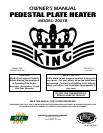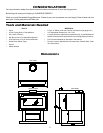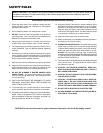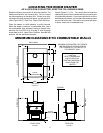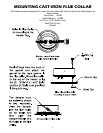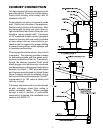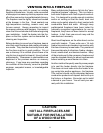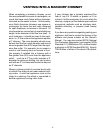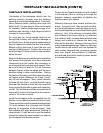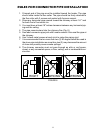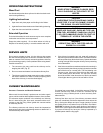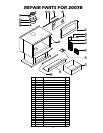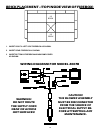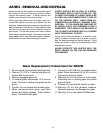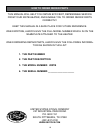
8
Many people may wish to convert an existing
replace to heater use. Usually, safe connection
of stovepipe to a masonry chimney requires more
effort than connection to a prefabricated chimney.
The replace must be tightly closed and sealed
at the damper in the ue. Good sealants are
high-temperature caulking, ceramic wool, and
furnace cement. Always remember to inspect
the masonry chimney and replace. If necessary,
clean the ue and smoke shelf before beginning
your installation. Install the heater into the re-
place so that the system can be dismantled for
cleaning and inspection.
Before deciding to convert your replace, keep in
mind that some replaces and existing chimneys
are unsafe. They must be structurally sound, and
the ue liner must be in good condition. Do not
use a chimney if it is unlined (should have a re
clay tile liner to protect brickwork). Have it relined
professionally. Clearances to combustibles are
explained in the previous section on masonry
chimneys. If you have any questions regarding
the condition of the chimney, consult a qualied
engineer, competent mason, or knowledgeable
inspector.
CAUTION:
NOT ALL FIREPLACES ARE
SUITABLE FOR INSTALLATION
OF A WOOD HEATER.
Many prefabricated replaces fall into the "zero-
clearance replace" category. This is a factory-
built metal replace with multi-layered construc-
tion. It is designed to provide enough insulation
and/or air cooling so that the base, back and
sides can be safely placed in direct contact with
combustible oors and walls. Although many
prefabricated replaces have been tested by
nationally recognized organizations for use as
replaces, they have not been tested to accept
heaters. In fact, their use as such may void the
manufacturer's warranty.
Steel-lined replaces, on the other hand, can be
used with heaters. These units use a 1/4-inch
rebox liner and an air chamber in connection with
8 inches of masonry to meet code. They contain all
the essential parts of a replace, rebox, damper,
throat, smoke shelf, and smoke chamber. Many
of them look exactly like a masonry replace and
must be checked closely for above requirements
before installing a wood heater into them.
Another method frequently used by some people
is to vent the heater directly into the replace.
This does not meet code since the heater is be-
ing vented into another appliance - the replace.
This method should not be attempted because
combustion products will deposit and build up in
the rebox or replace. Be certain not to install
a hazard in your house. You will void your war-
ranty with this installation.



